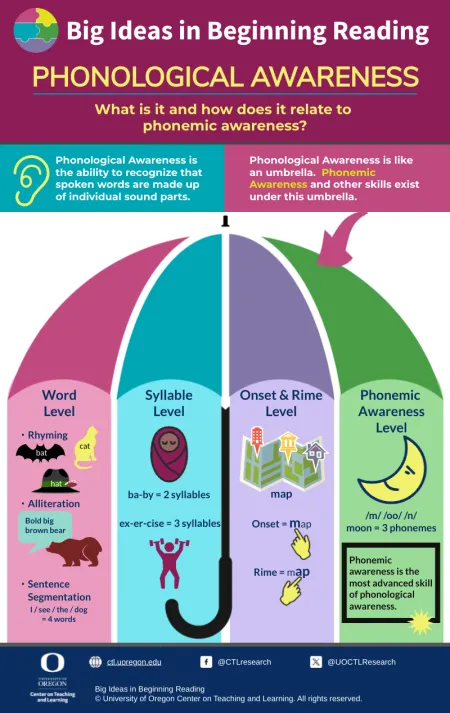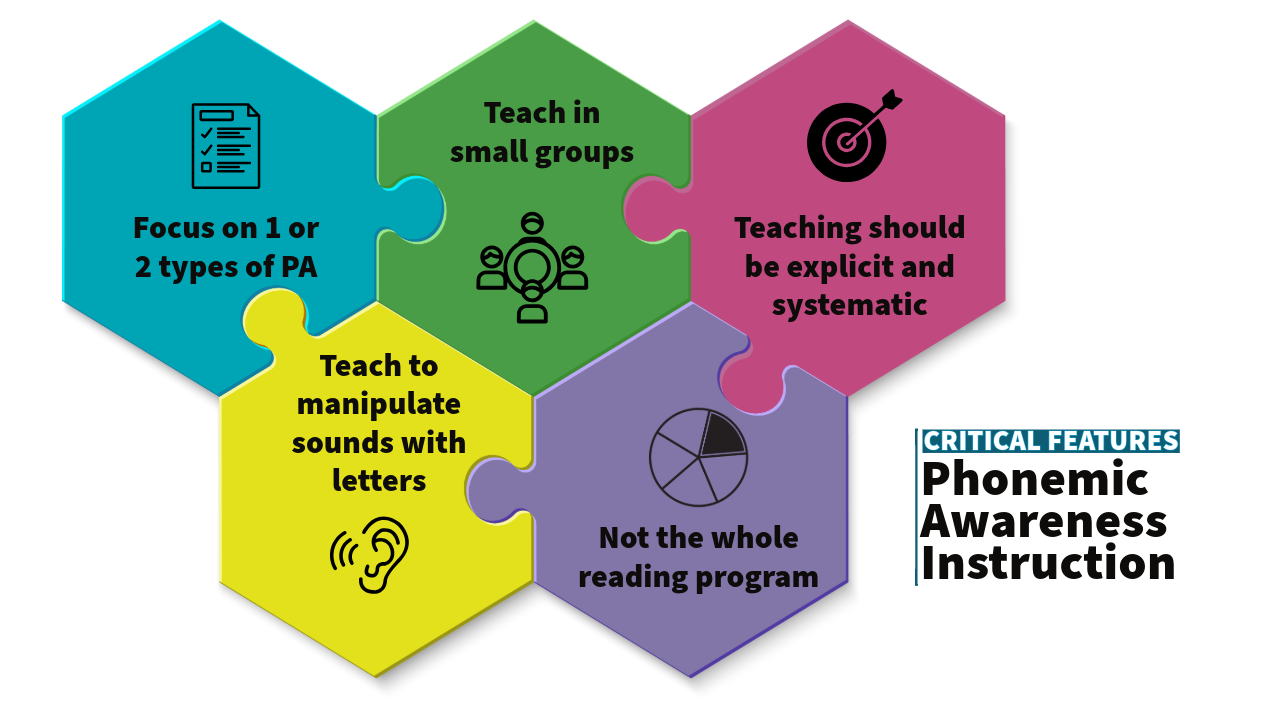The ability to recognize and manipulate individual sounds in spoken words. Phonemic Awareness is a crucial precursor to reading and is entirely auditory, meaning it does not involve written letters.
We often think of reading as looking at words, but it actually begins with listening. This important skill is called phonemic awareness. On this page you will learn about effective phonemic awareness instruction and its importance in reading development. You can help your child develop this skill by playing games that focus on listening for and identifying sounds in words.
Overview
Mini Mastery - Phonemic Awareness
What is Phonemic Awareness?
Phonemic Awareness is the ability to identify and manipulate individual sounds in spoken words. It is essential for learning to read in an alphabetic writing system and a strong predictor of children who experience early reading success – so in other words, if a child can do phonemic awareness tasks, they will most likely be a good reader.
To understand phonemic awareness, it’s important to understand that it is the most advanced skill of Phonological Awareness. Phonological Awareness is an umbrella term that encompasses the ability to recognize that spoken words are made up of individual sound parts. Phonemic Awareness exists under this umbrella, along with other levels of phonological awareness. These levels progress from larger sound units to the smallest sound unit and include the ability to distinguish sounds at a word-, syllable-, onset-rime-, and phoneme-level.
So, phonemic awareness is a skill within phonological awareness that emphasizes an ability to play with words at the smallest unit of sound by identifying, categorizing, isolating, blending, segmenting, adding, deleting, and substituting individual phonemes in words.
What does Phonemic Awareness look like?
For starters, it is an auditory skill. It is the task of being able to pull apart words into their individual phonemes, the smallest unit of language, when heard. Purposeful phonemic awareness instruction includes:
- Identifying: Recognizing a first sound in a word.
- Example: "What is the first sound you hear in cat?" (/k/)
- Matching: Taking a beginning sound and noticing it is the same as other beginning sounds.
- Example: "Choose a picture that matches the first sound /d/. Dog and Door".
- Categorizing: Grouping beginning sounds together that are the same.
- Example: "Is the /k/ in cat the same as the /m/ in map? Is it the same as the /k/ in cap? Is the /k/ in cat the same as the /k/ in can? Cat, Cap, and can start with the same sound".
- Blending: Putting phonemes together to say a word.
- Example: "What word is made up of the sounds /k/ /ă/ /t/?" (cat)
- Segmenting: Saying each phoneme in a word.
- Example: "What are all the sounds you hear in cat?" (/k/ /ă/ /t/)
- Deleting: Removing a phoneme to change a word.
- Example: "What is cat without the /k/ sound?" (at)
- Substituting: Changing a phoneme to make a new word.
- Example: "What word would you have if you changed the /t/ in cat to an /n/?" (can)
- Adding: Which is Adding a phoneme to make a new word.
- Example: "Add /k/ to rash. What is the new word?" (/k/ rash=crash)
How do we teach phonemic awareness?
- Keep lessons short. Less than 15 minutes.
- Focus on only 1 or 2 phonemic manipulation activities in a lesson.
- Use materials that reduce memory load and help represent sounds. For example, using pictures to help children remember the words and to focus their attention or using a 3-square strip or blocks to represent sounds in a word.
- Tie it to your instruction in reading and writing. So, present an auditory task focused on phonemic awareness, then include the same target sounds in words that students will practice reading or spelling.
- Once children can blend and segment sounds easily, use letters during lessons as a transition to phonics. Seeing the letters help children associate which sounds go with which letters.
Finally, why is phonemic awareness important?
- It helps children get ready for reading and writing, understand that words are made of smaller sounds and helps them sound out words as they read and write.
- One of the common differences between readers who struggle and those who don’t, is strong phonemic awareness.
- First graders who cannot blend sounds into words, or segment words into sounds are likely in need of phonemic awareness intervention. Some students will also need word-level and spelling instruction to explicitly link sounds to print.
Phonological Awareness: What is it and how does it relate to phonemic awareness?
Phonological awareness is the ability to recognize that spoken words are made up of individual sound parts.
Phonological awareness is like an umbrella that includes different skills, including Phonemic Awareness. These levels progress from larger sound units to the smallest sound unit and include the ability to distinguish sounds at a word, syllable, onset-rime, and phoneme level.
Word Level:
- Rhyming: Recognizing words that end with the same sound, like bat, cat, and hat.
- Alliteration: Noticing when words start with the same sound, such as "Bold big brown bear."
- Sentence Segmentation: Breaking down sentences into individual words. For example, "I / see / the / dog" has four distinct words.
Syllable Level:
- Identifying the separate sound chunks within a word. "Ba-by" has two syllables, while "ex-er-cise" has three.
Onset and Rime Level:
- Dividing a syllable into its initial consonant sound (the onset) and the vowel and any following consonants (the rime). In "map," "/m/" is the onset and "/ap/" is the rime.
Phonemic Awareness Level:
- This is the most advanced skill of phonological awareness. It involves recognizing and manipulating the smallest individual sounds within words, called phonemes. For instance, the word "moon" is made up of three phonemes: /m/ /oo/ /n/.

Download Infographic
Role in Reading
The role of phonemic awareness is to introduce students to the alphabetic principle, or the idea that letters and letter combinations represent speech sounds of a writing system.
Phonemic awareness instruction typically spans two years, kindergarten and first grade. Oral activities in kindergarten focus on simple tasks such as rhyming, matching words with beginning sounds, and blending sounds into words. In first grade, phonemic awareness tasks are more advanced, focusing on blending, segmentation, and the substitution and manipulation of phonemes.
Critical Features of Phonemic Awareness (PA) Instruction

Focus on 1 or 2 types of PA: Focusing instruction on a few specific skills yields stronger outcomes. While phonemic awareness(PA) includes many subskills, research consistently identifies blending and segmenting at the phoneme level as the most critical for early reading success.
Teach in small groups: Finally, instruction is more effective when delivered in small groups rather than to the whole class. This allows for more individualized practice and support, which can lead to better student outcomes.
Instruction should be explicit: Teachers must clearly demonstrate the target skills before asking students to try them. Modeling is a key component of effective teaching in this area.
Teach to manipulate sounds with letters: Although phonemic awareness is primarily an auditory skill, instruction becomes more effective when it incorporates letter manipulation. Once students are familiar with the concept of individual sounds in words, teachers can use visual aids such as letter tiles or squares to help children form sounds and build words.
Not the whole reading program: Phonemic awareness is an essential part of reading instruction, but it is not a complete reading program on its own. Effective instruction should be brief—no more than 10 to 15 minutes per day.
Assessment in Action
Phoneme Segmentation Fluency Scoring
Watch this video to see a demonstration of phoneme segmentation fluency assessment. For more information, see the DIBELS Research Site.
The Science of Reading
Decades of research have confirmed that phonemic awareness is a key predictor of reading success. Teaching phonemic awareness to children significantly improves their reading. For this reason, it’s critical that a child learning to read receives explicit and systematic phonemic awareness instruction.
Key Citations and Research
- Shanahan, T. (2005). The National Reading Panel report: Practical advice for teachers. Learning Point Associates. https://www.nichd.nih.gov/publications/pubs/nrp/smallbook
- Ehri, L. C., & Roberts, T. (2006). The roots of learning to read and write: Acquisition of letters and phonemic awareness. Handbook of Early Literacy Research, 2, 113-131.
- Foorman, B. R., & Torgesen, J. (2001). Critical elements of classroom and small‐group instruction promote reading success in all children. Learning Disabilities Research & Practice, 16(4), 203-212.
- Moats, L. C. (2020). Teaching Reading" Is" Rocket Science: What Expert Teachers of Reading Should Know and Be Able to Do. American Educator, 44(2), 4.

